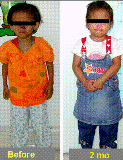
 |
| News & Outreach |
|
||||||
Global Health MattersSeptember - October, 2007 | Volume 6, Issue 5
Mortality Rates Decrease in HIV-Infected Children Initiating HAARTA study of HIV-infected children in Thailand, funded by Fogarty's Global Research Initiative Program for New Foreign Investigators (GRIP) program, offers new data to support the effectiveness of a life-saving treatment known as highly active antiretroviral therapy (HAART). The treatment has been shown to slow the progress of disease and prolong survival in HIV-infected adults; similarly HAART has changed the course of HIV disease in children. There are an estimated 15,000 children with HIV/AIDS in Thailand. In 2002, the Thai Ministry of Public Health launched the National Access to Antiretroviral Program for People Living with HIV/AIDS program with the aim of providing universal access to treatment for all HIV-infected Thai patients who meet national-guidelines criteria for the initiation of antiretroviral therapy. The program provides generic antiretroviral drugs produced in-country with the average cost of $1 per day. This program enabled Chiang Mai University Hospital's Dr. Thanyawee Puthanakit and her research team to evaluate hospitalization and mortality among HIV-infected Thai children after receiving HAART.  Dr. Thanyawee Puthanakit and her team have studied HIV-infected children in northern Thailand. (Photo: T. Puthanakit) The team observed all HIV-infected children who began receiving HAART, from August 2002 to March 2005, at four hospitals in northern Thailand. The 192 patients included in the study were HIV-infected children who were antiretroviral naive, except for exposure to antiretroviral drugs as part of the prevention of mother-to-child HIV transmission. All of the children, except two, were infected perinatally. The mean age at the time of HAART initiation was 7.6 years. The children received a three-drug regimen: 113 received stavudine, lamivudine and nevirapine; 73 were given stavudine, lamivudine and efavirenz; and six received zidovudine, lamivudine and nevirapine. They were observed for at least 48 weeks and data were censored at 144 weeks. The study documented the effectiveness of the HAART program. There was significant reduction in the mortality rate from 5.7 percent in the first six months of therapy to 0 to 0.6 percent during the following six-month interval. The hospitalization rate was also remarkably reduced from 30.7 percent in the first six months after HAART to 6.7 percent and 2.3 percent in the second and third years after initiation of HAART.  A five-year old girl with HIV/AIDS after two months of HAART. The research team found identification of the causes of hospitalization and deaths are essential to decrease the high early mortality rate of children initiating HAART. The higher early mortality in low-income populations is likely due to low CD4 cell counts, more advanced clinical stage, and the prevalence of coexisting infections at the time of HAART initiation. Dr. Thanyawee Puthanakit's GRIP award supported research examining the effect of the HIV epidemic on children in Thailand. Hospitalization and Mortality among HIV-Infected Children after Receiving Highly Active Antiretroviral Therapy. Puthanakit T, Aurpibul L, Oberdorfer P, Akarathum N, Kanjananit S, Wannarit P, Sirisanthana T, Sirisanthana V. Clinical Infectious Disease 2007; 44(4):599-604. Access the paper [PDF] Should you require Adobe Acrobat for viewing PDFs, current and free accessible plug-ins are available at the Adobe website.
|
|||||||
|